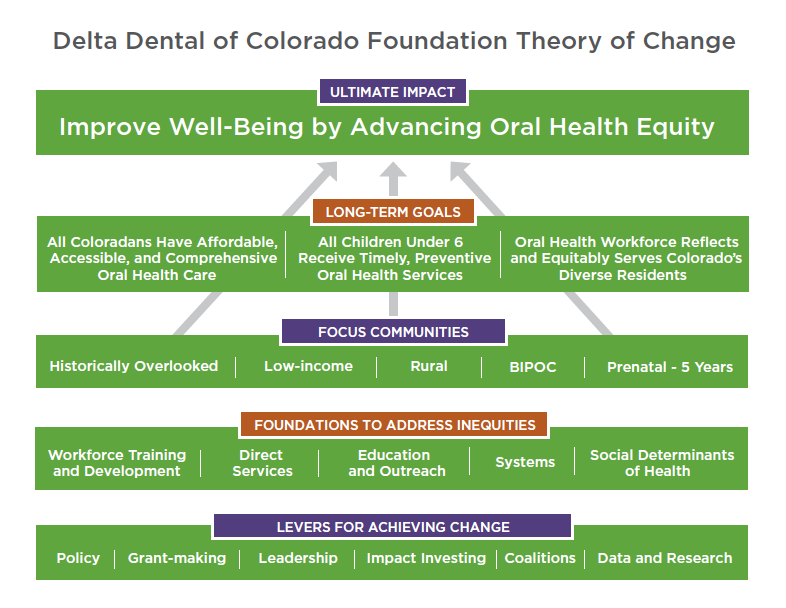Oral Health Research
Data and research are important levers for achieving change. It’s well documented that health disparities are closely linked to race and ethnicity, income, geography, and age. Oral health outcomes are no different. The following is a collection of data ranging from a national, state, and organizational level.
National level: Oral Health in America: Advances and Challenges is a culmination of two years of research and writing by over 400 contributors. As a follow-up to the Surgeon General’s Report on Oral Health in America, this report explores the nation’s oral health over the last 20 years. This report provides a nationwide lens that informs and aligns with DDCOF’s work.
State level: Populations who have historically been overlooked due to race, ethnicity, income, geography, or age often face health care barriers in many Colorado communities. More Coverage, Same Care is an oral health brief that uses insights from the 2021 Colorado Health Access Survey to illustrate challenges to access and use of oral health care. It proposes both questions and actions for policymakers and stakeholders interested in advancing oral health equity in Colorado.
Organizational level: To measure the impact of our mission of advancing oral health equity, the foundation partners with the Colorado Health Institute to serve as independent evaluators. The DDCOF 2021 Evaluation Report is focused on DDCOF’s responsive-funding grantees, with supplemental insights and data about invited grantees, the CO MDI program, and other DDCOF efforts in 2021. The insights gleaned from this evaluation will be instrumental in guiding the foundation through 2022 and beyond as we adapt to meet the needs of Colorado communities through the lens of improving oral health equity.
Health Inequities Related to COVID-19
- Rural communities have a higher percentage of workers deemed essential than the Front Range’s cities and suburbs. Two essential sectors dominate rural employment — agriculture and education/health care/social services, according to the census data used for the index. (Colorado Health Institute)
- Black Coloradans make up 3.9% of Colorado’s total population but represent about 7% of coronavirus cases. Hispanic/Latino residents make up about 21.7% of the state’s population, but represent 28.1% of the coronavirus cases. Both groups are subject to systemic disparities that make them more prone to chronic ailments such as diabetes, asthma and heart disease. (The Colorado Department of Public Health and Environment)
- The Social Distancing Index shows the most crowded homes are in the neighborhoods around the edge of Denver County — Westwood in southwest Denver and Montbello in the northeast, the Adams County suburbs along Interstate 25 and west of the Rocky Mountain Arsenal Wildlife Refuge, and northwest Aurora near the border with Denver. These neighborhoods have some of the lowest incomes in the metro area. (The Colorado Health Institute)
- Immigrants in the U.S. represent approximately 17% of the labor force working in major industries such as health care, social assistance, educational services, construction, agriculture, food services and retail trade. Unfortunately, many immigrant workers and their families won’t benefit from the COVID-19 relief packages signed into law in March. (Community Catalyst)
Oral Health Inequities in Colorado
- Nearly one in five Coloradans (18.4%) report fair or poor oral health, up from 16.2 percent in 2017. (2019 Colorado Health Access Survey)
- Older adults have the highest rate of medical coverage (almost 100%) but the lowest rate of dental insurance at 52.7%. (2019 Colorado Health Access Survey)
- Only 51% of African Americans visited the dentist in the last year compared to 66% of all Coloradans. (The Colorado Health Institute)
- Fifty-seven of Colorado’s 64 counties are designated a Dental Health Professional Shortage Area. (The U.S. Health Resources & Services Administration)
- Just 63% of Coloradans with incomes at or below 133 percent of the federal poverty level report both good physical and oral health status. (The Colorado Health Institute)
More Research Resources
- Learn more about the state of oral health in Colorado Health Institute’s report, Ensuring Smiles, as well their Oral Health one-pager. These are part of their 2019 Colorado Health Access Survey, providing information on health insurance coverage, access to health care, and use of health care services in Colorado.
- Find tools and resources from around the country to learn more and implement oral health best practices using the American Academy of Pediatrics’s Oral health Prevention Primer.
- The DACA/Undocumented/Migrant Community Health Toolkit is the collective effort of MSU Denver Health Scholars whose wish was to underscore the importance of access to health for these communities. Pages 7-8 speak to oral health.
- The Colorado Self-Sufficiency Standard calculates how much income a family must earn to meet basic needs without public or private assistance based on family composition in each of Colorado’s 64 counties.
- Examine oral health strategies and Colorado needs to do to implement its own approach in Open Wide for Opportunity, a paper developed by the Colorado Health Institute.
- Learn more about how water fluoridation improves oral health across our state: http://coloradowaterfluoridation.org/
- The Colorado Trust’s Social Determinants of Health review some of the many the social determinants and poses important questions to consider when addressing how they can impact your health.
- Read Colorado Rural Health Center’s Snapshot of Rural Health in Colorado
- Visit The State of Babies to see how Colorado’s infants, toddlers, and their families are doing measured by Good Health, Strong Families, and Positive Early Learning Experiences.
- This fact sheet by FamiliesUSA covers some of the the potential benefits of Medicare oral health coverage for Coloradans.


